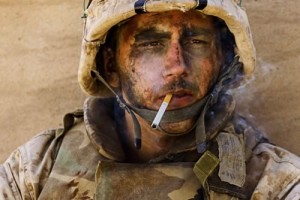 When Saigon fell, and the last Huey was pushed into the sea, Americans looked back with dismay on the foreign entanglements that had culminated in calamity. Those who cared to look ahead saw little prospect of war. Surely, they thought, the nation had learned from a war that had cost fifty-eight thousand lives and ended in defeat.
When Saigon fell, and the last Huey was pushed into the sea, Americans looked back with dismay on the foreign entanglements that had culminated in calamity. Those who cared to look ahead saw little prospect of war. Surely, they thought, the nation had learned from a war that had cost fifty-eight thousand lives and ended in defeat.
Americans settled into a period of inwardness and few saw the new way of war coming. The military rebuilt itself, independent of the breadth of society, and became the most fearsome army in the world. War-making, in astonishing contrast to post-Vietnam sensibilities, became a de facto presidential power, legitimized by national security arguments only desultorily debated.
This power was ceded by congress and endorsed by a gratefully uninvolved nation who see war service as something for others.
The Post-Vietnam Nation
Confident that an old militarized society had expended itself, Americans concentrated on careers, consumerism, and privacy. Life became more atomized and hedonistic.
The military drafted over a million young men during the Vietnam War – a major basis for opposition to the war. Military service had once been an obligation, a duty owed one’s country, but amid the war, it was seen as an unjustifiable intrusion on education and privacy.
When Richard Nixon became president in early 1969, he shifted the combat burden onto the S Vietnamese army. By the end of 1970, US troop levels had been reduced 30%, casualties 55%. Nixon also reduced, then later ended, conscription, and based the military on volunteers and pay incentives. Service was no longer a national duty.
Partial Reemergence of support for war
In 1979, Iranian students seized the US embassy in Tehran and held the staff hostage for well over a year. Many Americans saw the events as an understandable response to past meddling. Many others, however, were angered that a small country could humiliate them.
Patriotic and even martial sentiments swelled. Aversion to the use of force had been a mistake. People yearned for the day when America’s prestige and might were supreme, when all nations respected us, or at least feared us.
In the 1980 election, Ronald Reagan invoked images of the frontier, traditional heroes, and the victory of World War Two. This was based more on Hollywood than on actual events, but wars and politics are usually clouded by myth. Reagan won handily and embarked on an effort to revitalize patriotism, with pride in military power the centerpiece.
Military spending went up sharply. The nation recommitted itself to the global contest with the Soviet Union – an “evil empire” against which American virtue and might were once again pitted. WW2 battleships – symbols of the nation’s power and its victory at sea – were returned to active duty. As the economy recovered from a deep recession, all seemed right in the land once more.
Today’s Military
The military is far more homogeneous than in previous wars. It is drawn disproportionately from rural areas and small towns where orientations toward military service and national traditions are far stronger than in cities and suburbs, and where Vietnam is a shameful event in the nation’s history – one that must never be repeated and one that had to be avenged.
Soldiers acquire a great deal more training than counterparts did during World War Two and Vietnam. Mastery of weaponry, physical power, and long-term solidarity with fellow soldiers created, in time, an extraordinary professional ethos that has only a little resonance with the experience of veterans of previous wars, most of whom simply put in their time for the duration, often grudgingly.
A quick campaign in Grenada (1983) brought effusive public praise – quite unexpected in quarters still attuned to post-Vietnam expectations. Six years later, George H Bush sent troops into Panama for another splendid campaign, and in 1991 the military devastated the Iraqi army in a few days. American might was once again shining and seemingly limitless. The problems of the world could be quickly solved by military action.
Wars and Public Life
Wars no longer involve the public as they had in every war since the Continental Congress raised forces to win independence. Even the Vietnam War, oversimplified as a poor man’s war, drew from the middle- and upper-middle classes as not every young man from upper strata availed himself of deferment. Pride in military service was still pervasive at the outset of that war, though it became one of its unenumerated and unmourned casualties.
For most Americans, there is neither cost nor involvement. A bumper sticker or a silent moment during the news suffices as a show of support for soldiers. Only graying and aged veterans question the justness of the casualties falling so heavily on narrow social strata.
The Iraq War led to spirited but unfocused protest rallies. Most were more like colorful folk festivals than concerted political action. The issue at hand was intermixed with, and obscured by, unrelated causes. Demonstrations sought to recreate the antiwar movement of the sixties – a time of romantic and mythic meaning to the gathered. Opposition had little effect on the prosecution of the war or the president’s reelection.
Few Americans today openly criticize the military, regardless of its judgment or conduct. That would be deemed unpatriotic and threaten to revisit the divisiveness of the sixties. Few Americans today have any substantive acquaintance with military matters and cannot speak from experience or with insight, only with great passion – most of which is short-lived.
©2011 Brian M Downing